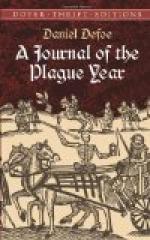This brings these two men to a further remembrance. The name of one was John Hayward, who was at that time under-sexton of the parish of St. Stephen, Coleman Street (by under-sexton was understood at that time gravedigger and bearer of the dead). This man carried, or assisted to carry, all the dead to their graves, which were buried in that large parish, and who were carried in form, and, after that form of burying was stopped, went with the dead cart and the bell to fetch the dead bodies from the houses where they lay, and fetched many of them out of the chambers and houses; for the parish was, and is still, remarkable, particularly above all the parishes in London, for a great number of alleys and thoroughfares, very long, into which no carts could come, and where they were obliged to go and fetch the bodies a very long way, which alleys now remain to witness it; such as White’s Alley, Cross Keys Court, Swan Alley, Bell Alley, White Horse Alley, and many more. Here they went with a kind of handbarrow, and laid the dead bodies on, and carried them out to the carts; which work he performed, and never had the distemper at all, but lived about twenty years after it, and was sexton of the parish to the time of his death. His wife at the same time was a nurse to infected people, and tended many that died in the parish, being for her honesty recommended by the parish officers; yet she never was infected, neither.[146]
He never used any preservative against the infection other than holding garlic and rue[147] in his mouth, and smoking tobacco. This I also had from his own mouth. And his wife’s remedy was washing her head in vinegar, and sprinkling her head-clothes so with vinegar as to keep them always moist; and, if the smell of any of those she waited on was more than ordinary offensive, she snuffed vinegar up her nose, and sprinkled vinegar upon her head-clothes, and held a handkerchief wetted with vinegar to her mouth.
It must be confessed, that, though the plague was chiefly among the poor, yet were the poor the most venturous and fearless of it, and went about their employment with a sort of brutal courage: I must call it so, for it was founded neither on religion or prudence. Scarce did they use any caution, but ran into any business which they could get any employment in, though it was the most hazardous; such was that of tending the sick, watching houses shut up, carrying infected persons to the pesthouse, and, which was still worse, carrying the dead away to their graves.
It was under this John Hayward’s care, and within his bounds, that the story of the piper, with which people have made themselves so merry, happened; and he assured me that it was true. It is said that it was a blind piper; but, as John told me, the fellow was not blind, but an ignorant, weak, poor man, and usually went his rounds about ten o’clock at night, and went piping along from door to door. And the people usually took him in at public houses




